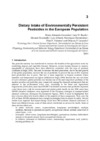Please use this identifier to cite or link to this item:
https://accedacris.ulpgc.es/jspui/handle/10553/4833
| Title: | Dietary intake of environmentally persistent plaguicides in the european population | Authors: | Almeida-González, Maira Boada, luis d Zumbado, Manuel Henríquez Hernández, Luis Alberto Fernández Valerón, Pilar P. Luzardo, Octavio |
UNESCO Clasification: | 3214 Toxicología | Issue Date: | 2011 | Abstract: | Global pollution has become one of the most important problems of the modern societies and pesticides play a major role among the chemical contaminants that are released to the environment every year. Organochlorine compounds have been widely used in the past all over the world as pesticides and some of them are still used for the control of vectors of infectious diseases. Due to their high lipophilicity, stability and resistance to degradation, most of them have been banned or strictly regulated but their levels remain high in the environment as persistent organic pollutants (POPs). Their presence in the environment leads to their introduction into the food chain, especially affecting food of animal origin with higher fat content. Due to their liposolubility, these substances tend to be bioaccumulated into the fat tissues of living beings along their entire lives, and to be biomagnificated across trophic levels in the food chain. Thus, the main human source of these pesticides comes from the daily intake of contaminated food from environmental sources. It has been established the role of many of the POPs as endocrine disruptors and even as carcinogenic agents, being thus considered as important risk factors for health. Moreover, chronic exposure to pesticides, even at very low levels, has been related with cancer, fertility problems, immunosuppression and other diseases. For this reason, it is important to know the level of POPs contamination and to identify the main sources contributing to it. Fish, meat and dairy products are the food groups with the highest levels of pollution. However, the residue levels vary by geographic area, and are influenced by several factors as food security policies, local pesticide use patterns, environmental practices, or the time when the study is conducted. Food habits, conditioned by different social and economic factors, as well as several biological factors (i.e. gender, sex and age), determine the levels of POPs exposure in the population. \nThe purpose of this chapter is to give an overview of the dietary intake of environmentally persistent pesticides by the European population, and the potential adverse consequences of this exposure on human health. | URI: | https://accedacris.ulpgc.es/handle/10553/4833 | ISBN: | 978-953-307-531-0 | Source: | Stoytcheva, Margarita (ed.). Pesticides. The Impacts of Pesticides Exposure [ISBN: 978-953-307-531-0] Publisher: InTech. |
| Appears in Collections: | Capítulo de libro |
Page view(s)
203
checked on Dec 21, 2024
Download(s)
133
checked on Dec 21, 2024
Google ScholarTM
Check
Altmetric
Share
Export metadata
This item is licensed under a Creative Commons License

